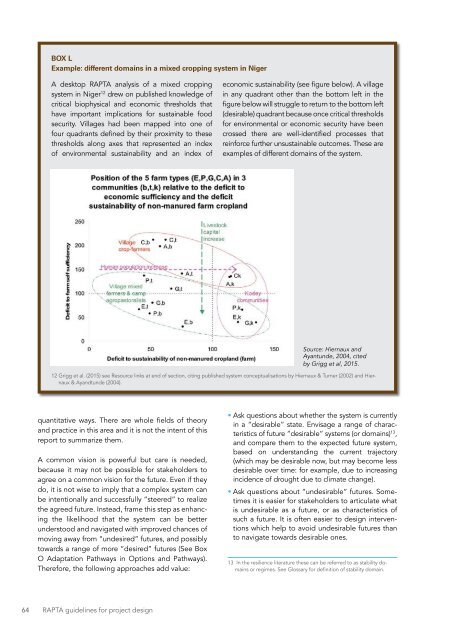DESIGNING PROJECTS IN A RAPIDLY CHANGING WORLD
srun3013fp1
srun3013fp1
Create successful ePaper yourself
Turn your PDF publications into a flip-book with our unique Google optimized e-Paper software.
BOX L<br />
Example: different domains in a mixed cropping system in Niger<br />
A desktop RAPTA analysis of a mixed cropping<br />
system in Niger 12 drew on published knowledge of<br />
critical biophysical and economic thresholds that<br />
have important implications for sustainable food<br />
security. Villages had been mapped into one of<br />
four quadrants defined by their proximity to these<br />
thresholds along axes that represented an index<br />
of environmental sustainability and an index of<br />
economic sustainability (see figure below). A village<br />
in any quadrant other than the bottom left in the<br />
figure below will struggle to return to the bottom left<br />
(desirable) quadrant because once critical thresholds<br />
for environmental or economic security have been<br />
crossed there are well-identified processes that<br />
reinforce further unsustainable outcomes. These are<br />
examples of different domains of the system.<br />
Source: Hiernaux and<br />
Ayantunde, 2004, cited<br />
by Grigg et al, 2015.<br />
12 Grigg et al. (2015) see Resource links at end of section, citing published system conceptualisations by Hiernaux & Turner (2002) and Hiernaux<br />
& Ayandtunde (2004).<br />
quantitative ways. There are whole fields of theory<br />
and practice in this area and it is not the intent of this<br />
report to summarize them.<br />
A common vision is powerful but care is needed,<br />
because it may not be possible for stakeholders to<br />
agree on a common vision for the future. Even if they<br />
do, it is not wise to imply that a complex system can<br />
be intentionally and successfully “steered” to realize<br />
the agreed future. Instead, frame this step as enhancing<br />
the likelihood that the system can be better<br />
understood and navigated with improved chances of<br />
moving away from “undesired” futures, and possibly<br />
towards a range of more “desired” futures (See Box<br />
O Adaptation Pathways in Options and Pathways).<br />
Therefore, the following approaches add value:<br />
• Ask questions about whether the system is currently<br />
in a “desirable” state. Envisage a range of characteristics<br />
of future “desirable” systems (or domains) 13 ,<br />
and compare them to the expected future system,<br />
based on understanding the current trajectory<br />
(which may be desirable now, but may become less<br />
desirable over time: for example, due to increasing<br />
incidence of drought due to climate change).<br />
• Ask questions about “undesirable” futures. Sometimes<br />
it is easier for stakeholders to articulate what<br />
is undesirable as a future, or as characteristics of<br />
such a future. It is often easier to design interventions<br />
which help to avoid undesirable futures than<br />
to navigate towards desirable ones.<br />
13 In the resilience literature these can be referred to as stability domains<br />
or regimes. See Glossary for definition of stability domain.<br />
64 RAPTA guidelines for project design


